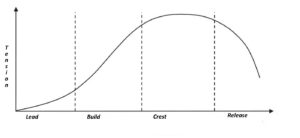Flat screens got you down? FOMO running your life? Selfie-addicted? Heed the warning signs! These practices have entrained your brain – your entire system actually – to run at an inhuman speed that, honestly, is going to kill you. So, it’s high time to take back your life from your tech.
To make this easier to swallow, let’s use the old left/right brain analogy. This saddles the “left brain” with responsibility for all the technical, analytical aspects of our being, and that’s all good for the duration of this article (about five minutes). Now, we want to contrast that with the “right brain” and show how this contrast offers you a potential way forward.
An imaginary right brain spa
We used to believe all the creative, non-linear, intuitive stuff happened in the right brain, and that the left brain did all the heavy lifting. Thank God for science (irony intended) and a more updated, holistic view of the brain. Whether left, right, or something else, it’s the “right brain” part of us that tech fails to feed.
None – that’s right: none – of what fuels that part of us comes directly from a flat screen. At its best, apps and a flat screen can only remind us of what we used to experience in real life…and that’s not enough for real health. Flat screen is not real life. Repeat: flat screen is not real life.

What if we could send our “right brain” selves on a spa weekend? What would that look like? What would it feel like? Imagine, if you will….
You check in Friday afternoon. The lobby feels like the sitting room in a modern mansion: glass, cement, a ceiling that disappears, comfortable but elegantly simple furniture. A sexy, tanned concierge sitting across the coffee table from you signs you in and collects all your tech – smartphone too – and locks them safely away. You’ve agreed that, for this weekend, you won’t be needing them.
After a shower, you head up to the pool deck. Perfect temperature. Excellent live music. There’s a sunset more stunning than usual. The attendant offers you your favorite libation, prepared just the way you wanted (you were very thorough on the pre-retreat questionnaire), and suggests you relax before dinner. This is a challenge because around you everyone else looks a bit on edge, a bit confused. You begin to feel that way, too. Things seem disorganized. You remember an email you meant to send….
STOP!
How can there be any massive value in this? Let’s ask that question a different way: what is the massive value of you…alive, productive, and content?
How can we transform our dangerous default flat-screen tendencies? If, as The New York Times suggests, avoiding screen time is a status symbol, then the cost – and exclusivity – of our imaginary right-brain spa could be too high for regular tech-addled people who may not even know the danger signs.
Life…or death in the flat-screen matrix
Not to be morose, but don’t you want to outlive the average life expectancy? Even if you’re a clean-living income-autopilot vegan yoga nomad meditator, your tech is still killing you. Tech is especially destructive to early development, from kids to teens.

Yes: tech is necessary to life these days. But it’s killing us!
Beyond the harmful RF and EMF radiation and whatever else is physically dangerous about our tech – that is, eye and brain strain from addictive use of our tablets, laptops, smartphones, and HDTVs, microwaves, or simply related dangers such as crossing the street without looking up at traffic.
Are there cognitive impairments to your adult highly-evolved homo sapiens-based processing ability? There certainly are. Beyond the mental, what are the physical, emotional, perhaps even spiritual risks of too much tech? As you might guess, they are high.
Tech has evolved much faster than we have. Tech challenges us to keep up, jack in, be a part of the matrix. And we took the red pill without thinking too carefully about the consequences.
What happens to a human system that runs way over hot all the time?
Either you keep up or you die, right?
This isn’t meant to scare you, but the early results ought to: you can’t keep up without damaging the system. None of us can.
Let’s move beyond all that tech-based doomsday evidence to sustainable solutions that won’t reduce your life expectancy.
What does your system crave?
Systems that don’t get proper maintenance simply die. Especially human ones. STEM and popular notions of meaningful work these days favor the analytical, left-brain aspects of our human systems. After all, those parts of human activity made all this tech possible and highly profitable, and we’d like to keep things that way, right?
 Scientific advances in genetic engineering and quantum computing are amazing, and neuroscientists such as Christof Koch are pushing our understanding of the biology of consciousness. The rapid developments in AI and VR hold a kind of romantic allure for us, even as the ethical questions of all this advancement circulate without clear answers.
Scientific advances in genetic engineering and quantum computing are amazing, and neuroscientists such as Christof Koch are pushing our understanding of the biology of consciousness. The rapid developments in AI and VR hold a kind of romantic allure for us, even as the ethical questions of all this advancement circulate without clear answers.
With genetic engineering, for example, we can create new organisms, modify existing ones, and potentially cure cancer and other diseases, but what about the downside? Bad actors could use this same tech for harm.
The neuroscience of how human beings respond to information and repetition explains the success of activities such as effective advertising and successful sales. Now that same science has been deployed to influence voters, distribute news (both real and fake), guide healthcare choices, and advise anyone looking for online answers. This makes it difficult but not impossible for our human systems to discriminate between the truth and the noise (perhaps we need an app for that).
Is there any right-brain fuel for us in all the technological noise?
We just can’t assume that homo sapiens suddenly no longer require the holistic care we have used for millennia. Have human beings evolved so fast that we no longer need to feed the non-analytical aspects of our human systems? The evidence doesn’t support a positive answer to that question. Intentionally lobotomizing one half of our brain can’t be a good thing, and yet tech over time tends to do that. How can we keep up?
Have we have sacrificed our right brains to feed the flat screen beast?
What does your entire human system really crave?

The 21-Day Miracle
In his best-selling book, The 21-Day Miracle, author, business advisor, motivational speaker, and the #1 Marine Corps F/A-18 instructor Ed Rush explains how anyone can accomplish anything in 21 days. He also explains what to do with the other 7 days you’ll have every month when you’re not doing miracles: rest and recover.
Ed’s position is that the human system isn’t designed to run hot and fast 24/7/365. Marine Corps aviators and others in super-stress occupations know this. Regular human beings with whatever superpowers they may have? We tend to try to defy the odds. You can learn about what happens to a real-life 24/7/365 team when it doesn’t use rest properly in this fascinating long read about the collision between USS Fitzgerald and MV ACX Crystal. The story makes Ed’s point in real life.
Work hard and smart for twenty-one days, rest for seven. Makes sense. If you’ve guessed that the twenty-one “on” days are more left-brain intensive, you’d be correct. The seven days “off” are your opportunity to give the right brain what it craves. By doing that, you also intervene with the negative forces tech exerts on your whole system.
Get the seven-day part of this right and you’ll be ready for the next twenty-one-day sprint. If you fail to intentionally feed the right brain during those seven days, you’re headed into deeper danger, right alongside the captain and crew of the USS Fitzgerald.
Interventions for your tech and a bit of historical perspective
Yoga is a fashionable right-brain fix these days, as is meditation. Both are used for intervention, but their true powers lie in focus and presence, not remediation. There’s nothing wrong with a quiet, focused mind, but wouldn’t you like to experience your mind in all its inventive, creative power? Of course you would. If you could only silence the part of you that’s always on….

Have you ever thought about why mathematics and music, for example, seem so compatible? People like to think that it’s because of the similar left-brain aspects of math and music, and that’s part of the answer, but what if it goes deeper?
As you recall great polymaths such as Leonardo Da Vinci or Galileo, consider how their superpowers ranged over the entire left/right brain analogy. Did you know that in ancient China and Greece, political leaders were poets, painters, or musicians? Scientists and political leaders with holistic capabilities? Seems right somehow.
Perhaps ultra-specialization wasn’t a consideration in antiquity, but it might be useful to wonder why is it that many mathematicians have a natural tendency to support their highly-developed left-brain specialized abstraction abilities with highly-developed right-brain holistic musical ones.
In the last century or so, the violinist Albert Einstein became famous for E=mc2, and a number of other modern-ish musicians have made contributions to our scientific understanding. This same kind of left brain / right brain balance also seems to happen with modern political leaders. Winston Churchill was a talented painter. Before he became President, Richard Nixon was famously cajoled on national television into performing a piano concerto he composed, but not before taking a jab at President Truman’s considerable pianistic abilities. Bill Clinton’s saxophone playing may have tipped more than the election in his favor.
Feeding the right brain
Do music, poetry, and art feed the right brain? Based on the small but well-accepted anecdotal evidence cited here, you bet they do. The bigger question is: do they feed yours? How can you put some STEAM in your STEM?

Music, poetry, painting – all of the creative arts in fact – give rise to the right-brain fuel our human systems crave. In fact, this is much more than balancing (or silencing!) the abstraction of scientific, technical, engineering or mathematical work. The Arts actually fuel essential parts of us in ways that STEM/tech simply can’t.
As tech pulls us further into universal addictive abstraction, we have also become more aware of concrete practices such as Shinrin-yoku (the simple medicinal power of being in a forest), regular attendance at symphony concerts, or studying the work of transcendent artists. All of these holistic practices feed the right brain in ways that tech just can’t.
Time out! You’re saying Tech can’t deliver The Arts?
Yes, you’re correct: tech is very good at delivering the arts for easy use and consumption. It’s so easy to virtually visit an art exhibit, live stream a concert, or research creative endeavors. Tech makes all that possible. The point here is that, while a flat screen can put The Arts right in your hand, helpful healthful holistic engagement with The Arts is juice you’ll just never suck from a flat screen.
Let’s take the popular example of making a musical soundtrack for your life, which used to be thought of favorably before Musimorphic showed us more intelligent ways to use music. For example, many of us grew up on flat screen sitcoms of one kind or another. Some of them are brilliant, some not so much. Most have bump music at either end and some have through-composed background music.
We, entrained by flat screen content like that, feel naturally inclined to bring music into our lives. We’ve built playlists for exercise, relaxation, travel, hanging out, sex, you name it. We can stream almost any music we want and for any purpose. So, with all that music around us, why aren’t we getting the right-brain fill-up we need? Soundtracking your life actually compounds the tech issue because it keeps your addled left brain super-processor on overdrive! Much better to let the left hemisphere of your brian spin freely while the right side does the real restorative or creative work.

This is intriguing, though, because right brain resists direct action. It’s slippery that way. It doesn’t play football and it doesn’t play chess: it paints, plays in the mud, doesn’t have a schedule. It attends drum circles and goes on hikes in the mountains without ever knowing why. The right brain has to be enticed, cajoled, misdirected. It’s not possible to play music to it while left-braining on some other task. Things happen in the right brain that don’t obviously and immediately connect to the left brain.
But don’t believe what you read here unless you test it for yourself, or find a reliable corroborative source. To save your left brain some effort, take a few minutes to watch neuroanatomist Jill Bolte Taylor give her famous TED talk: “My Stroke of Insight.” Go ahead. Do that now. Or, if you prefer, try meditating and count your exhalations: if you can count ten of them, come back and finish reading this article. Or put on some Metallica and really listen for the joy in it. Or pull up a painting by Rothko on your giant flat screen and try to learn what it is telling you. Read that book.
Did you choose the tech-based alternatives from the previous paragraph? Thought you might! That’s one way to use tech for the good of your right brain. It’s not as great as the real-life experience of a Metallica concert or standing in front of a Rothko, but perhaps you found Dr. Taylor’s experience captivating.
We must start somewhere, and there’s a lot of left brain STEM/tech to roll back before we can get to the right brain STEAM juice.
What is it about The Arts?
The Arts have a way of reaching our right brains. The Arts feed that part of us. We remove The Arts from education and find kids learn slower, make fewer connections in the corpus callosum (that’s the left/right brain communications channel), and aren’t as dexterous as their arts-connected childhood peers.
Science has worked hard to deliver that particular set of insights about The Arts, and yet we persist in our left-brain STEM-driven rush toward…what? You already know: all kinds of issues we could choose to avoid.
In this regard, people in The Arts whose practice depends on centuries of knowledge share some of the common insights “discovered” by their friends in The Sciences. And yes: it’s true that people in The Arts are using tech just as heavily as the average bear.
The Arts – even walking in the forest is an art these days – invite us to check our left brains at the door, along with our tech, and immerse what’s left of us. Like a healthy mineral or mud bath, it helps. It’s part of the reason people take themselves on intentional tech-free “holidays.”
What will you do?

What doesn’t kill us makes us stronger
Our collective immersion in tech is just not sustainable, and some kind of massive Darwin Award is the best any of us can hope for on our current path. But human beings are a resilient lot, and we’ve survived several attempts at self-extermination in the past. Short of the threat of global nuclear war, though, the dangers of technology may be the next best (worst?) warning to humankind to reconnect with what really matters, what really sustains us best.
As you read this, you can choose to opt out of using technology harmfully, or not. You can give yourself an edge over the tech-addicted left-brainers, or not. There’s no linear progression from turning down your tech to true bliss; but there’s an absolute guarantee that, if you can even find your bliss, it won’t lead to a flat screen. Unless your bliss is making addictive sequels to really great movies, of course.
So, push your tech and yourself to the limit as you like. Homo sapiens tend to learn best under pressure, and cheating death is great pressure. The Arts have been around a long while, and they will be waiting for you when approximately half of your brain explodes. At that moment – the moment you turn away from your tech and turn toward The Arts – you will have evolved into the kind of human being capable of sustaining our race.
Do that. You deserve it.

A word to fellow travelers
If this sounds like it was written by an art snob, it wasn’t. Fortunately, early practice in The Arts helped give the author a way to move through chronic depression, even suicidal thoughts and feelings. The Arts have been his lifeline in many ways, both practical and ethereal. If you find yourself starving for something more than the lure of technology, reach out here.
Ready for a deeper dive? The Musimorphic Quest, a fully-mentored online active-learning experience will immerse you in practical ways to meet life’s challenges with skills you may not realize you already have. It’s not for everybody, but you are that unique individual who really resonates with with the power of music and wants to learn to wield it with skill, give it a try. The landing page is here.
Take Back Your Life From Your Tech



